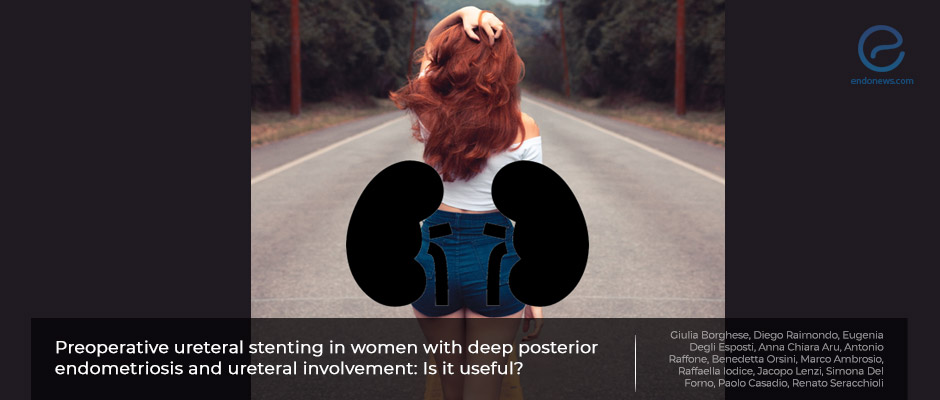Routine preoperative ureteral stent and complications in Deep Infiltrating Endometriosis
Nov 3, 2021
Ureteral stent insertion should NOT be a preoperative routine for DIE patients
Key Points
Highlights:
- Routine ureteral stent insertion does NOT lower complication rates, it should be decided perioperatively.
Importance:
- Routine ureteral stent insertion is associated with a longer duration of hospitalization and a higher low urinary tract infection rate.
What's done here:
- This is a retrospective study comparing 2 different time intervals, by routine ureteral stent insertion (2014-2016) to the selective perioperative insertion (from 2016).
- The placement was done to all patients with posterior DIE nodules (>3 cm) and/or grade I–II hydronephrosis in the first period (n=88).
- In the second period, the ureteral stent was placed only in patients with grade III-IV hydronephrosis and/or urinary bladder trigone involvement (n=96).
- The two groups were compared for perioperative complication rates to examine the complications and operation duration time.
- Demographic data, ureteral involvement, location of all endometriotic lesions, and surgical procedure performed to treat posterior DIE have been noted.
Key Results:
- Low urinary tract infections were statistically higher in the prophylactic insertion group. Also, the hospital stay was almost 3 days longer.
- No significant difference was found between the two groups related to operation time and the kind of surgical procedures that had to be applied.
- While grade 3 complications including fistulas and perforations seem higher in the 1st group the overall complication rate was similar and no statistical difference was verified.
Limitations:
- It is a single-center retrospective study and the improvement in technology and surgeons' experience over time may affect the results.
Lay Summary
Deep infiltrative endometriosis is a devastating disease that includes both anterior and posterior compartments, and ureteral infiltration with endometriotic nodules affects 1 to 6% of all deep infiltrative endometriosis patients.
In the study conducted by Giulia Borghese et al., the outcomes of prophylactic ureteral stent insertion have been investigated by comparing 2 groups, one with prophylactic stent and the second with the perioperative decision for the stent. The article has recently been published in the "International Journal of Gynaecology & Obstetrics".
The retrospective study by comparing two different time intervals for the routine insertion (2014-2016) to the selective perioperative insertion (from 2016) has been applied. In the first period, placement was performed on all patients with posterior deep infiltrating endometriosis patients with nodules bigger than 3cm, and/or grade I–II hydronephrosis at preoperative assessment. In the second period, the authors restricted the prophylactic ureteral stent placement only for patients with grade III-IV hydronephrosis and/or urinary bladder trigone involvement.
The groups were compared for perioperative complication rates, for investigating the complications and operation duration time. Demographic data, ureteral involvement, location of all endometriotic lesions, and surgical procedures performed to treat posterior deep infiltrating endometriosis have also been noted.
Eighty-eight women in the first group and 96 in the second group have been included in the study. Low urinary tract infections were statistically higher in the prophylactic insertion group, and the hospital stay was almost 3 days longer. No significant difference was found between the two groups related to operation time and the kind of surgical procedures that had to be applied. Although the grade 3 complications including fistulas and perforations seem to be higher in the 1st group, the overall complication rate was similar and no statistical difference was verified.
According to these results, the authors concluded that systematic stent insertion should not be suggested because of the increase in urinary infection rates and hospital stays while not adjusting the complication rates.
Research Source: https://pubmed.ncbi.nlm.nih.gov/34606100/
ureteral endometriosis urinary tract. ureteral stent

